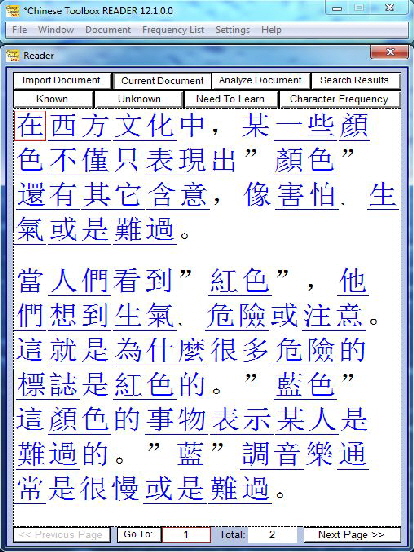The Solution to Problems in Learning Chinese
Learning to read well in any language requires spending a significant amount of time actually reading. This is as true with Chinese as with any language, but for those learning Chinese as a second language, a number of issues intrinsic to Chinese make reading much more difficult than with most other languages. Chinese Toolbox was created specifically to help one overcome the challenges of learning Chinese. These challenges are related to Chinese characters and Chinese words.
Chinese Characters
For westerners seeking to learn Chinese, just about all problems boil down to the following three points:
- There’s a lot of characters to learn. Over 27,000 exist in the character dictionary that ships with Chinese Toolbox, and you need to know 3000 to 4000 characters just to read a Chinese newspaper.
- Characters (for the most part) are complex. Very few characters can be written with 1 to 3 strokes.
- There is no Chinese alphabet. Quickly looking up a character in print material requires a good understanding of Chinese characters, and there is no easy ordering of characters as there is with an alphabet.
Traditionally, one learns to write characters while learning to read them. Children in Taiwan and China spend many hours writing and learning to read several characters each week, and their reading material is based mostly on what they’ve learned to write.
Adult learners of Chinese normally do not have the same luxury, and as a result, reading progresses much more slowly, so slowly that learning to read can be extremely frustrating. Chinese Toolbox was designed to significantly pick up the pace of reading among adult learners. Learning to write Chinese is recommended, but with Chinese Toolbox, you don’t have to learn to write characters before you read them. Just import any Chinese text that you would like to read into Chinese Toolbox. When you select a character (via mouse or keyboard), the character entry is shown in the Character Dictionary window.
Chinese Toolbox makes it very easy to read Chinese and to keep track of what you’ve learned. Reading provides exposure to the Chinese language; the more you read, the more exposure and familiarity you’ll have toward Chinese characters. And if you can recognize Chinese characters, you can also write those characters using a computer.
Chinese Words
The following is part of a story about colors:
在西方文化中,某一些顏色不僅只表現出”顏色”還有其它含意,像害怕ˎ生氣或是難過。當 人們看到”紅色”,他們想到生氣ˎ危險或注意。這就是為什麼很多危險的標誌是紅色的。”藍 色”這顏色的事物表示某人是難過的。”藍”調音樂通常是很慢或是難過。綠色這個顏色是給 忌妒的人們。有個說法”心中充滿妒忌”,那意味著某人真的想要一些屬於另外一個人的事 物。黃色這顏色表現害怕。不勇敢或是總是害怕的人們稱為”黃”。有些時候人們稱他們為” 膽小鬼”。小雞也是黃色的,不是嗎?
Notice how everything is run together. Chinese does not use spaces to delineate words. Just knowing where words in Chinese begin and end is a huge challenge to most people learning Chinese as a second language.
When the same text is viewed in Chinese Toolbox (below), the relationship between characters and words of Chinese is immediately apparent. For those with some experience in Chinese, just knowing where the words begin and end may be sufficient to be able to read a document.
 As you can see, words in Chinese Toolbox are underlined. When a Chinese word is selected, its entry appears in the Word
Dictionary window. Chinese Toolbox supports editing of the word dictionary, so you can edit, add or remove Chinese words from the dictionary.
As you can see, words in Chinese Toolbox are underlined. When a Chinese word is selected, its entry appears in the Word
Dictionary window. Chinese Toolbox supports editing of the word dictionary, so you can edit, add or remove Chinese words from the dictionary.
The greatest problem in learning the Chinese written language may simply be the volume of information, and this has everything to do with the Chinese writing system: characters. This is addressed in Chinese Toolbox via the system, Marking for Unassisted Reading. When you mark a character or word as Known, it is essentially removed from your list of things to learn, and you can focus your study effort on characters and words that you don’t know. Reading frequently provides the mental refreshing of what you had previously learned. As long as you read regularly, a flashcard type of review is not as necessary. Of course, if you don’t read much Chinese, you will gradually forget what you’ve learned, and flashcard review will seem to be the thing to do.

See the updates for
← Chinese Toolbox and Toolbox Coding
→
especially the new Chinese Toolbox 13.1.0.5.